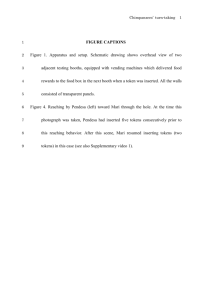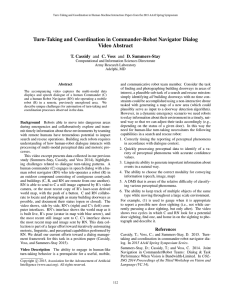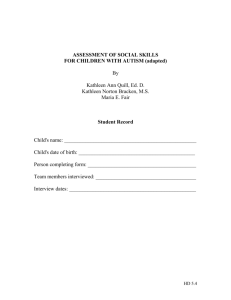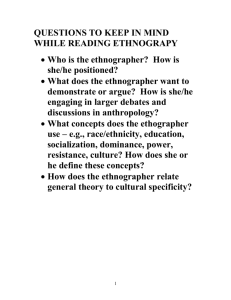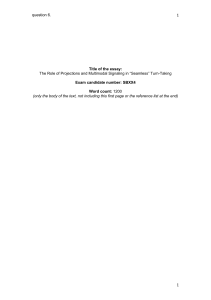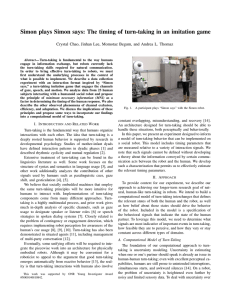Turn-Taking for Human-Robot Interaction Temporal Inference Model Turn-Taking
advertisement
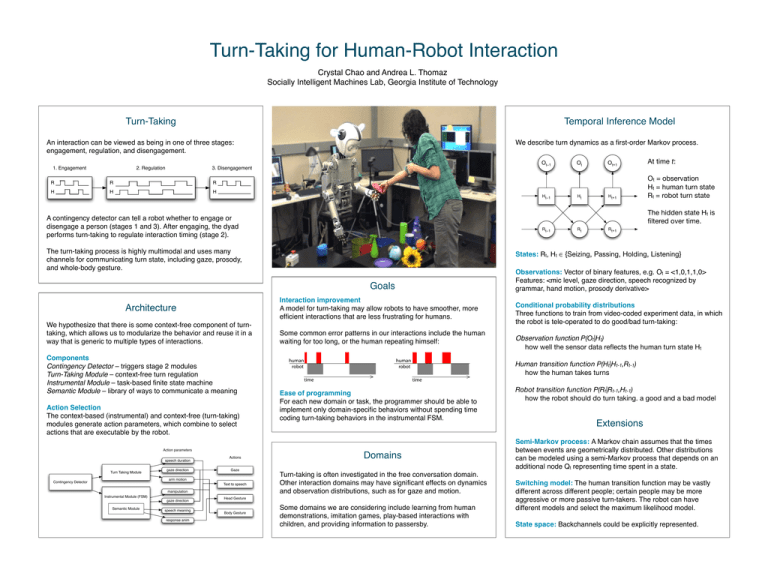
Turn-Taking for Human-Robot Interaction
Crystal Chao and Andrea L. Thomaz
Socially Intelligent Machines Lab, Georgia Institute of Technology
Turn-Taking
Temporal Inference Model
An interaction can be viewed as being in one of three stages:
engagement, regulation, and disengagement.
1. Engagement
2. Regulation
We describe turn dynamics as a first-order Markov process.
Ot–1
3. Disengagement
R
R
R
H
H
H
Ht–1
Rt–1
The turn-taking process is highly multimodal and uses many
channels for communicating turn state, including gaze, prosody,
and whole-body gesture.
Action Selection
The context-based (instrumental) and context-free (turn-taking)
modules generate action parameters, which combine to select
actions that are executable by the robot.
Action parameters
speech duration
Turn Taking Module
gaze direction
Actions
Gaze
arm motion
Contingency Detector
Text to speech
manipulation
Instrumental Module (FSM)
gaze direction
Semantic Module
speech meaning
response anim
Some common error patterns in our interactions include the human
waiting for too long, or the human repeating himself:
IVNBO
SPCPU
IVNBO
SPCPU
Rt
Rt+1
UJNF
Conditional probability distributions
Three functions to train from video-coded experiment data, in which
the robot is tele-operated to do good/bad turn-taking:
Observation function P(Ot|Ht)
how well the sensor data reflects the human turn state Ht
Human transition function P(Ht|Ht-1,Rt-1)
how the human takes turns
UJNF
Ease of programming
For each new domain or task, the programmer should be able to
implement only domain-specific behaviors without spending time
coding turn-taking behaviors in the instrumental FSM.
Domains
Turn-taking is often investigated in the free conversation domain.
Other interaction domains may have significant effects on dynamics
and observation distributions, such as for gaze and motion.
Head Gesture
Body Gesture
Ht+1
Ot = observation
Ht = human turn state
Rt = robot turn state
Observations: Vector of binary features, e.g. Ot = <1,0,1,1,0>
Features: <mic level, gaze direction, speech recognized by
grammar, hand motion, prosody derivative>
Interaction improvement
A model for turn-taking may allow robots to have smoother, more
efficient interactions that are less frustrating for humans.
Components
Contingency Detector – triggers stage 2 modules
Turn-Taking Module – context-free turn regulation
Instrumental Module – task-based finite state machine
Semantic Module – library of ways to communicate a meaning
At time t:
States: Rt, Ht ∈ {Seizing, Passing, Holding, Listening}
Goals
We hypothesize that there is some context-free component of turntaking, which allows us to modularize the behavior and reuse it in a
way that is generic to multiple types of interactions.
Ht
Ot+1
The hidden state Ht is
filtered over time.
A contingency detector can tell a robot whether to engage or
disengage a person (stages 1 and 3). After engaging, the dyad
performs turn-taking to regulate interaction timing (stage 2).
Architecture
Ot
Some domains we are considering include learning from human
demonstrations, imitation games, play-based interactions with
children, and providing information to passersby.
Robot transition function P(Rt|Rt-1,Ht-1)
how the robot should do turn taking. a good and a bad model
Extensions
Semi-Markov process: A Markov chain assumes that the times
between events are geometrically distributed. Other distributions
can be modeled using a semi-Markov process that depends on an
additional node Qt representing time spent in a state.
Switching model: The human transition function may be vastly
different across different people; certain people may be more
aggressive or more passive turn-takers. The robot can have
different models and select the maximum likelihood model.
State space: Backchannels could be explicitly represented.

